About The Author
Hello! From Chuchura (in Hooghly District) and a foodie, I created this blog with a mission to preserve the food of the land; with a message to encourage and promote clean and real food. I hope you enjoy and gain out of this blog, happy reading!
Looking forward to read and hear your feedback.
Chapor ghonto is counting its days to oblivion, just like many traditional Bengali dishes.
A few days ago there was a heated debate on where chapor ghonto originated.
While the jury is still out, it makes sense to dive deep into a dish that was a favorite for decades across rural Bengal.
What is Chapor Ghonto?
A Bengali, vegetarian, non-spicy dish that has lentil patties (daler bora) topped and mixed with vegetables and cooked with basic spices.
The Chapor (চাপড়) in Chapor Ghonto
As evident from the name, the emperor of this dish is chapor or chapri – a Bengali term that refers to flat-shaped fried lentil patties.
Generally, split pea lentils (মটর ডাল) are used to make the chapor (চাপড়).
Traditionally newly harvested lentils are considered for the best results.
Split pea lentils are cleaned thoroughly under running water and soaked overnight or at least for two to three hours. Then they are made into a paste and mixed with turmeric powder and salt.
To make the paste, a mixer-grinder may be used. No water should be added while making the paste.
This lentil patties are shallow fried in ghee for the best results.
Alternatively, mustard oil can also be used.
And why such a name?
The dal-based batter is pressed between the palms softly to give it a flat shape and hence the name.
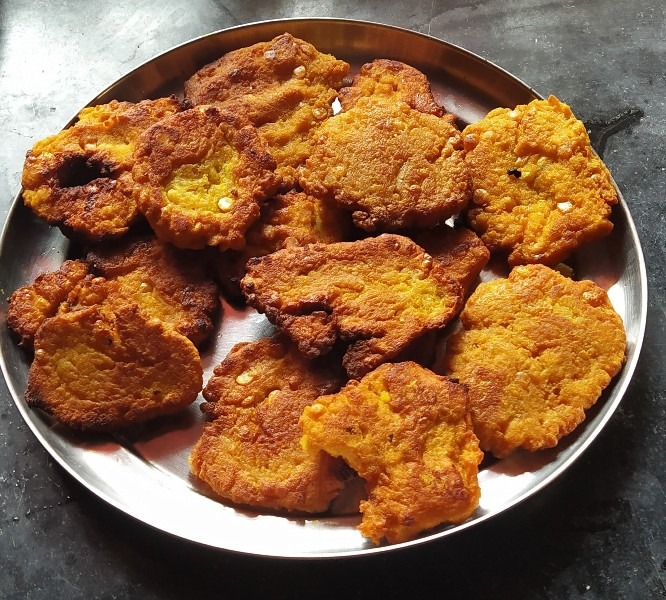

Regional Variants
While the overall recipe is similar, there are interesting differences based on the region.
Largely there are two regional variants – Barendra (বরেন্দ্র) and Rarh.
First, the similarities.
In both the variants, the tempering used is fenugreek seeds and mustard seeds.
Secondly, both the Rarh and Barendra style chapor ghonto does not recommend the use of tubers like potatoes and brinjals (or eggplants).
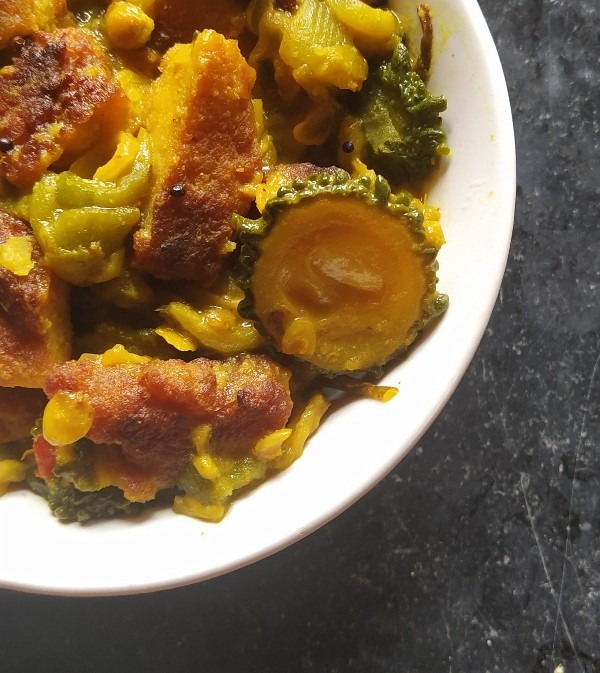
Rarh-based Chapor Ghonto
In the Rarh region of Bengal, the amount of chapor dominates the dish.
Maximum one or two types of vegetables can be used and this should not include any bitter vegetables.
The end result is sweeter.
Barendra-based Dish
A variety of vegetables (four or five different types) are used in the dish cooked in the Barendra region.
There must be one bitter dish – bitter gourd being the most common.
In the absence of bitter gourd, you may use leaves of helencha (হেলেঞ্চা or buffalo spinach) or cucumber to add in the bitter taste.
The chapor ghonto cooked in Barendra style is bitter.
| Item | Rarh Style | Barendra Style |
|---|---|---|
| Number of vegetables used | Maximum of two | Upto five |
| Bitter Vegetable Allowed? | No | Yes |
| Vegetables Allowed | Cucumbers, Ridge gourd, Pointed gourd | Bitter gourd (mandatory), banana stem (good to have), pointed gourd, ridge gourd |
| Vegetables Not Recommended | Any bitter vegetable | Cucumbers, Pumpkin |
| Flavor of the Dish | On the sweeter side | Mild bitter |
In this blog we have covered the Barendra-based chapor ghonto.
Can Chapor Ghonto be Classified as a Shukto (শুক্ত)?
This is an interesting theory that finds mention in the first cookbooks on Bengali cuisine.
And I kind of agree to it.
While the name of the dish contains the word ‘ghonto’ (ঘন্ট), technically it isn’t one.
Yes, the vegetables for this dish must be chopped finely, which is a requisite for a ghonto.
However, a ghonto always uses cumin seeds during tempering and almost never uses a bitter ingredient.
Two reasons why chapor ghonto is classified as a shukto (শুক্ত) in rural Bengal are as follows –
- Use of a bitter vegetable (mostly in the Barendra style dish)
- Use of fenugreek seeds and mustard seeds
Both these points point to one character of the dish – a bitter flavored dish. Not overtly bitter that makes you uncomfortable or throw up, but a subtle bitterness that Bengalis love.
Important Note on the Bitter Ingredient in Chapor Ghonto
While the bitter gourd is necessary in chapor ghonto, balancing the bitter flavor of the vegetable with the other ingredients and vegetables is important.
Using Mustard in Chapor Ghonto
The rule is to temper the oil with mustard seeds.
However, you may also add mustard powder.
Do not allow the mustard paste to saute or fry in oil. After adding the mustard powder, immediately add the vegetables and mix thoroughly.
In this recipe we have used mustard seeds.
What Vegetables Can Be Used?
The following vegetables can be used in a chapor ghonto.
- Bitter gourd (করলা) – only in Barendra regions
- Pointed gourd (পটল)
- Ridge gourd (ঝিঙে) – tender ridge gourds are preferable
- Jackfruit seeds (কাঁঠালের বীজ)
- Banana Stem (থোর)
- Raw papaya (পেঁপে)
- Spiny gourd (কাঁকরোল)
- Pumpkin (কুমড়ো) – In lesser quantities
- Cucumber (শসা) – In lesser quantities
- Brinjal (বেগুন) – In lesser quantities
- Potato (আলু) – In lesser quantities
Vegetables that are not recommended for this recipe include cauliflowers and cabbages.
Important: Vegetables with high water content
Cucumbers and vegetables with high water content are to be used in lesser quantities and should not be added directly.
For example, texts mention that cucumber should not be added directly.
Mix some salt with the cucumber and keep aside. This will draw out the water. For a curry that should be dry, this method prevents a watery curry.
The following recipe is cooked in Barendra style.
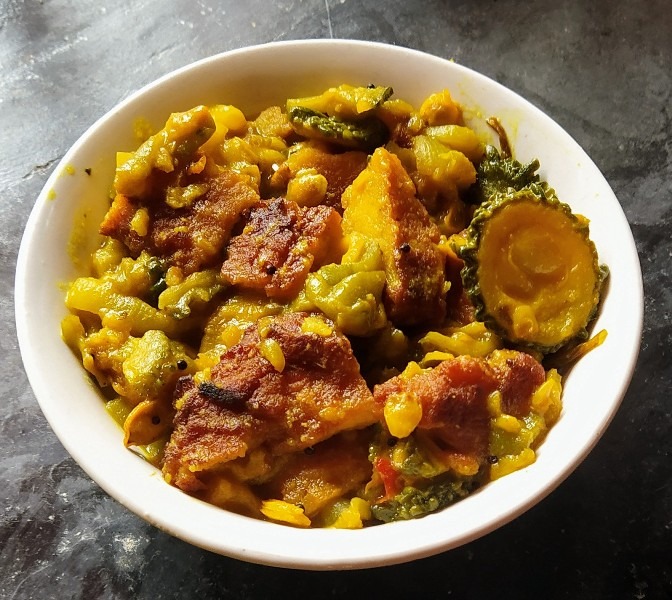
Note
The equipment & ingredient quantity provided in this recipe is to assist you in cooking this dish. Feel free to experiment with your ingredients. Remember that we all have different set, size & shape of kitchen tools in our pantry.
Equipment
- 1 Wok and spatula
- 1 Mixer and grinder (Mixie)
- 1 Knife and chopping board
- Preparation and serving bowls
Ingredients
For the Chapor in Chapor Ghonto
- 1 cup split pea dal (or Motor Dal)
- 4 cup water for soaking the dal only
- 1/3 tsp salt
- 1/3 tsp turmeric powder
- 4 tsp ghee or mustard oil
Vegetables Needed
- 125 g bitter gourd or karola
- 250 g wax gourd or potol
- 500 g ridge gourd
Other Ingredients Needed for Chapor Ghonto
- 2 tsp mustard oil or ghee
- 1 pc bayleaf for tempering
- 2 pc green chili to be used for tempering
- 1/2 tsp brown or black mustard seeds for tempering
- 1/3 tsp fenugreek seeds or methi to be used for tempering
- 1/2 tsp turmeric powder
- salt to taste
- 1 cup water
- 2 tsp ginger paste or preferably crushed fresh ginger
- 2 tsp ghee
Instructions
Preparation for Chapor Ghonto
- Wash the dal repeatedly in water to ensure that it contains no dust or impurities
- Soak the dal in enough water for at least 3 hours, preferably overnight
- Chop the veggies listed under "Vegetables Needed" finely. Keep separate
- Slit the green chilis
- Once the dal has soaked for the above-mentioned time, put them (without any water) in a mixie and grind to a paste. Ensure that it is not a fine paste, it must have some texture. Depending on the size of the grinding/mixing vessel, you may need to do it multiple times
- Put the dal paste in a bowl, add turmeric powder and salt as mentioned under "For the Chapor in Chapor Ghonto" and give give it a nice mix using a spoon or your fingers
How to Prepare the Chapor/Chapri
- Take a wok and put it on a medium flame
- Add mustard oil or ghee. I have used mustard oil
- Once the mustard oil smokes, take a portion of the dal mix on your palm. With the other palm press gently to give it a patty like shape. Alternatively, use a spoon to scoop in a portion of the dal paste
- Slowly and carefully, place the dal batter (or patty) on your palm or spoon into the wok. If you see that the dal patty isn't flat, use the back of the spoon to spread out the dal and give it a flat-like appearance. This needs to be done fast (before the dal fries in the oil/ghee and forms its shape) and carefully.
- If there is space in the wok, repeat the above steps again
- Fry on each end on medium heat for 2 minutes
- Using the spatula turn over to fry the other end for another minute or two
- When both sides are fried properly (resembling a light golden brown color), take them off and keep separately
- Repeat till the dal batter lasts

How to Cook Chapor Ghonto
- Add ghee or mustard oil to the wok
- When the oil smokes, add the temperings in order – bayleaf, slit green chilis, mustard seeds and fenugreek seeds (methi)
- When the mustard seeds start spluttering, add in all the vegetables
- Saute properly on high heat for 5-7 minutes
- Add turmeric powder, salt and water. Add enough water sufficient to cook the vegetables properly
- Cook covered for another 4-5 minutes
- In the meantime, break the chapris in smaller pieces
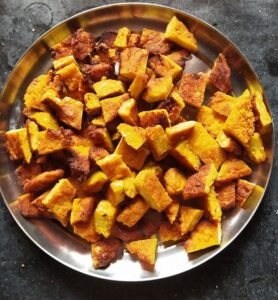
- Uncover the wok, add in the broken chapor or chapris
- Mix and cook till the water dries out
- Check for seasonings and if needed, adjust
- Add in freshly crushed ginger or use ginger paste
- Switch off the flame immediately and give the chapor ghonto a nice mix
- Add in the ghee and mix
- Serve with rice
Notes
- This recipe tastes the best when cooked with ghee
- Do not make a fine paste of the dal/lentils – it should be coarse to provide a bite and texture
- This recipe does not use tomatoes, red chili powder, cumin and coriander powders – as always simplicity defines the soul of the dish, not pound of spices
- Many prefer to improve the flavor of the chapor/chapri by adding minced green chilis and nigella seeds to the dal batter. Traditionally, this dish was a favorite among the widows and hence does not contain a lot of heating elements (chilis are heating elements)
- You may add in a teaspoon of sugar as is followed in the Barendra region
- You may add in a teaspoon of mustard oil before serving – this is often followed in the Barendra region
- The most important and challenging part while cooking a chapor ghonto is to balance the bitter flavor
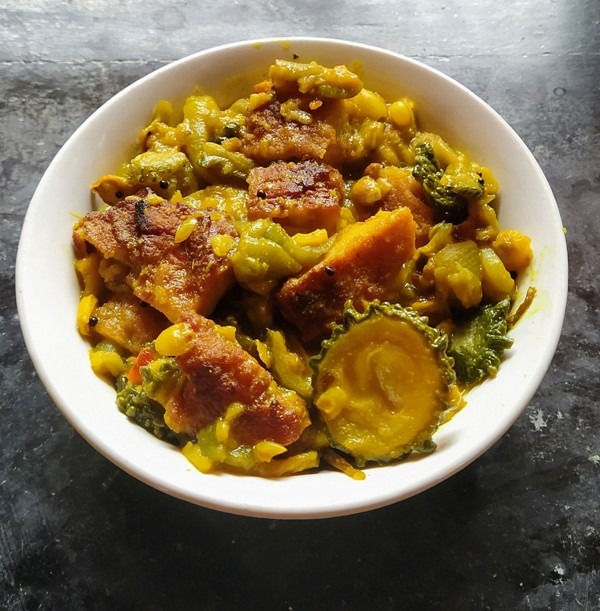

Excellent Barendra recipe. After my mother’s demise, none prepared this favourite dish. Thanks for posting.
Such meticulous information. Great effort by you.
Well defined.. Once I had made shukto from one of my bengali friend’s recipes and it was good too… But your is ghonto in which kalara is mandatory though….